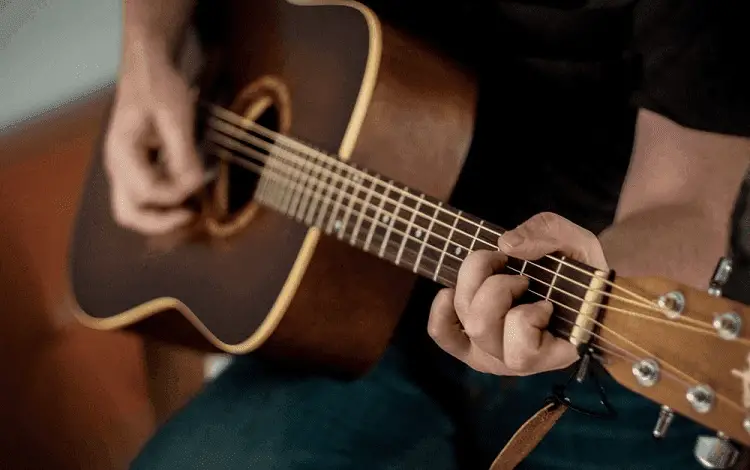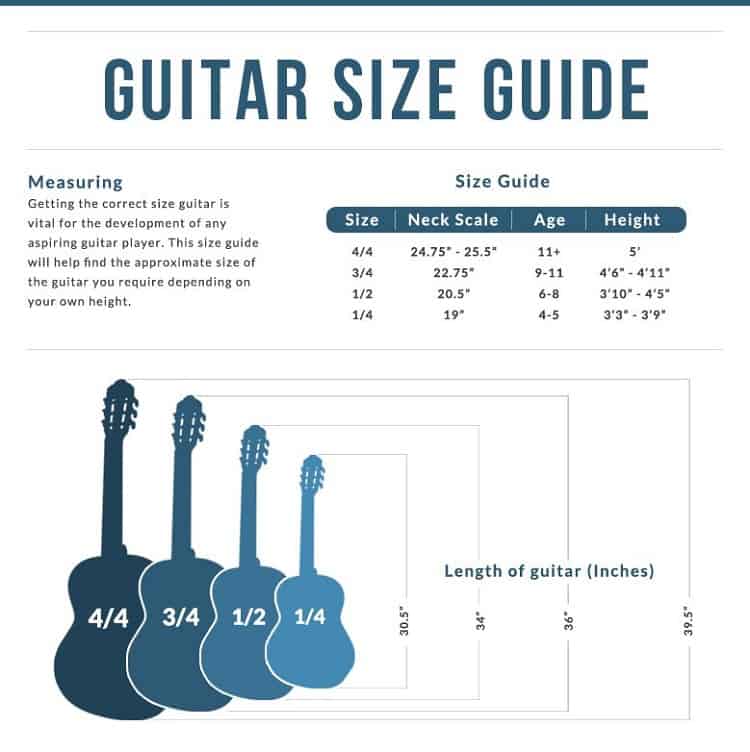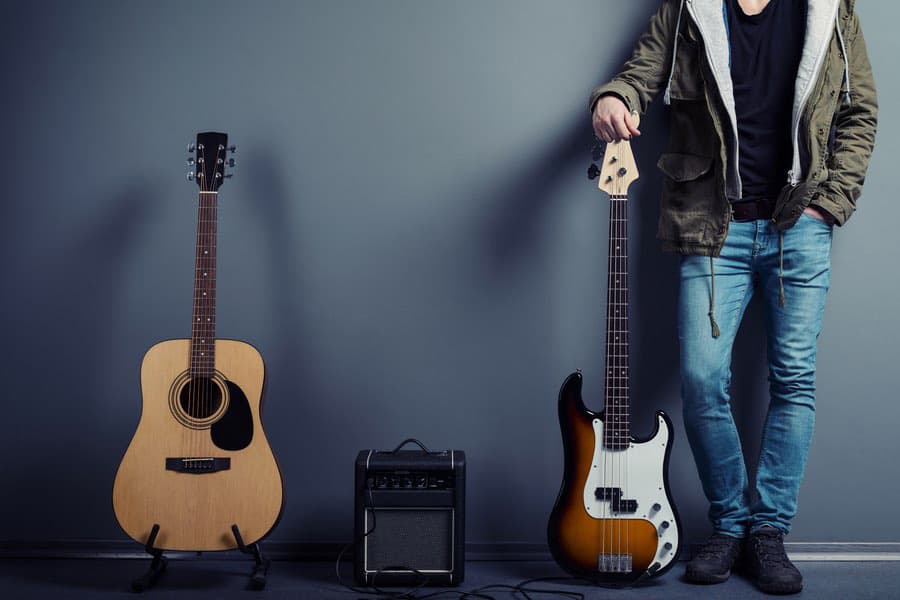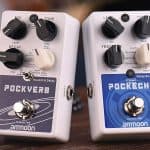So, you’ve decided that you want to learn how to play the guitar?
Playing an instrument is a great way to enhance your life, and stimulate your brain. There are lots of myths out there about the best way to learn how to play the guitar. Lots of people think that it’s easier to start on the acoustic guitar, some think the electric guitar is better.
There are many facts and reasons that people on both sides of the fence use to support their assertion that one type of guitar is better to learn on, than the other. But the reality is, when it comes to learning to play guitar, whether you’re interested in acoustic or electric, the basics are pretty much the same.
So, how do you decide where to start? Electric or Acoustic?
In this article, we’ll give you some thoughts on how to decide whether the electric guitar or the acoustic guitar is best to learn on.
And we’ll address some of the common myths associated with learning to play the guitar.
Contents
What’s Easier?

So this is probably the most confusing of the guitar myths.
Some people say that learning to play the acoustic guitar is the easiest, some people say that learning to play the electric guitar is easier. Ok, that’s really confusing.
So what is easier?
The fact is, both guitar types have their own challenges and benefits that make learning on them simple, but at the same time challenging. Let’s break this down.
Starting with the acoustic guitar – lots of people start playing the guitar on the acoustic version and transition to the electric. With the acoustic guitar, what you see is what you get.
You don’t have to worry about amplifiers, or wires, or extra accessories. The acoustic guitar is a simple, basic instrument. For some learners, this is the best reason to start with the acoustic guitar.
However, many learners think that the acoustic guitar is harder to play because the strings are thicker, and require more finger strength to depress. While this is the case, a good music store can restring an acoustic guitar with thinner strings.
And while string thickness can add challenges, the strings are set further apart, so finger placement is easier for beginners. Your fingers have room to move, and making chords is a bit more forgiving on an acoustic guitar than an electric.
On the flip side, lots of people like the idea of playing the electric guitar and think that it is an easier place to start. Electric guitars tend to be smaller in size, which can make them easier to manage. They also have thinner strings, which can be easier for small fingers to manipulate.
However, the electric guitar does require some extra equipment and these added extras might be too much for some learners, but at the same time an added incentive for others.
With both acoustic and electric guitars having pros and cons when it comes to ease, this is not the defining reason to pick one over the other. So, we’ll have to cover other factors to determine which guitar type you should start with.
Music Type

This may be the best way to decide which guitar type you should start learning on. Ask yourself this question, “What kind of music do I want to play?”
If you dream of one day being in a rock band and playing epic electric riffs, then you should start learning on the electric guitar. First of all, starting where your focus is, makes it more motivating to learn. If you really, really want to play rock music, learning the classics on an acoustic guitar can be disappointing. And unmotivating.
On the other hand, if you love classical guitar or have a thing for country or folk music, an electric guitar isn’t going to be your instrument of choice. If your interest lies in these genres of music, avoid starting with the electric guitar, and go straight to acoustic.
You’ll be able to learn the techniques of these music styles, and you’ll hear the right results from the get go. And, like we said with the electric guitar, picking the right instrument for the music you want to play, makes it easier, and more motivating to practice and play.
Cost

This is another big decider for some people. Cost. There is a big difference in cost of instruments between electric and acoustic guitars.
If you are on a budget, even if you want to play guitar in a rock band, you may want to first invest in an acoustic guitar. Acoustic guitars are relatively inexpensive, and require very few added accessories to make them work (we’ll discuss this next).
While they may not be the highest quality, you can buy a decent beginners acoustic guitar, for less than $100. For less than $200 you can get a complete beginners acoustic guitar kit that includes a case, strap, picks, and other handy accessories.
Of course, if you want a better quality instrument, you’ll pay more, but when you’re starting out, the basics will work great.
There are also affordable options on the market for beginner electric guitars. However, it is important to note that when it comes to quality and decent sound, you get what you pay for with electric guitars and their necessary accessories.
Your electric guitar will need an amplifier. Low cost amplifiers may not have great sound quality, and you may end up frustrated with how your music sounds.
To avoid frustration, invest in a better quality kit. Beginner electric guitar kits can start at less than $100, but you’ll find a better sound experience, if you start your shopping in the $200 range.
Necessary Extras

If you don’t want to haul around a bunch of extra stuff, and you just want to play music, your best bet is the acoustic guitar.
Like we mentioned before, you don’t need cords or amplifiers, or even straps or cases to make an acoustic guitar work. All you need is your fingers and a desire.
If you really want to play the electric guitar, you’ll just need to understand that there are some added extras that make the experience better, and could be considered necessary. To get the best sound experience from your electric guitar, you will need an amplifier and the necessary wires and cords that are used to connect your guitar to the amplifier.
Electric guitars also use pedals that can change and distort the sound that comes from your electric guitar. To get the most from your instrument, you’ll want to buy some extra pedals and play around with sound effects.
These added extras are fun, and make your electric guitar more diverse, but at the same time, if you’re on a budget, can be pricey.
Size

Size shouldn’t really be a determining factor, but it can be for some people. Electric guitars come in a variety of shapes and sizes. The size of the electric guitar generally won’t impact the sound quality or the construction quality of the instrument.
This variability in shapes and sizes can make the electric guitar more appealing for individuals of smaller stature. The ability to comfortably handle the instrument, and play without a big reach can be a big deciding factor, and oftentimes leads people to select electric guitars over an acoustic.
Most guitar teachers will tell you that you shouldn’t use a smaller size acoustic guitar. Smaller acoustic guitars are generally lower quality and often don’t have the best sound quality.
Even small adults and teenagers should start learning on a full-size acoustic guitar. The exception to this rule is for kids that are less than 10 years old.
Smaller children will struggle with the reach around a full size acoustic guitar. Youth sized acoustic guitars are perfect for younger learners, but they should move to a full size acoustic guitar as soon as they are able.
Sound Variability

This can be another big deciding factor for some people. To be frank, you only get one sound with the acoustic guitar. For some people this can be very appealing, for others, a turn-off.
If you are looking for an instrument that gives you a wide range of sounds and versatility in music styles, an electric guitar is right down your alley. Pedals and other distortion add-ons allow the player to make all sorts of sounds with a single electric guitar.
For kids (and some adults, too), this can be a fun motivator to encourage practicing and playing.
The simplicity of a single sound, may be attractive to some people, so if you want to keep it simple, and enjoy the sound of the acoustic guitar, this is the right choice for you.
Now that we’ve broken down the myths, and covered some of the reasons why people select one type of guitar over the other, the answer to our original question is, it really depends on you.
Neither guitar type is easier than the other to learn on. And each has its pros and cons when it comes to cost, sound and accessories. Our best advice is that you pick the instrument that best fits the style that you’re interested in.
This will make it more fun to play, and you’ll find that learning is easier and faster when you’re happy.



